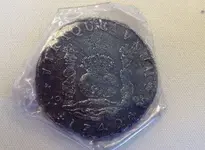There is a few things about the J. Swift silver mines that do not make much sense. So tell me if I am wrong. When JS and company mined the silver they would mention thousands of coined money from the silver and where they hid it. Why would they even attempt to mint silver coins in the wild. Makes more sense to me that they carried the silver ore out of Kentucky and minted the coins in North Carolina.
Is not that how Tug River got it's name from silver tugs with holes for rope to hold them together.
But if these men were pirates and their coins came from plunder of the Spanish Main then saying they counterfeited coins would be a good cover-up. Myself I believe the story was for land speculators so they could sell their thousands of acres of land, get Kentucky settled and get people to move in with their greedy hearts in tow.
I have no more knowledge of the details of the legend than anyone else, yet I will try to apply my perspective on what I have read thus far on the legend. I would imagine that once the ore is mined and then refined (smelted) it would be simpler to cast it into ingots (tugs or other various shapes). Then heated again and poured into coin molds to be impressed afterwards. Coins would be easier to carry than tugs, but if all the silver that was refined could not be poured into molds and impressed, they would be carried back as tugs/ingots.
Remember this is legend, probably based on SOME facts. I think its a mistake to take it all as chapter and verse fact or fiction. For one, some legends have them from N.C. while others VA. Were there two mines or two sets of mines? Did Swift find the first mine by chasing a bear into a cave or was Mundy the one who knew the location by working the mines for the indians?
I doubt seriously that they were pirates, they were avoiding the English crown (authority) by making the coinage in the wilderness. If they brought back bulk silver to the colonies it probably would have been taxed or taken from them. This was not a time of equal rights, property rights and other freedoms we currently have. The authority of the crown was absolute, and colonists were subjects to those laws made back in England. It makes no sense for them to risk life and limb with the Indians to go hundreds of miles inland to make coinage when they could have done it on a isolated beach along the Eastern seaboard.
The land speculation aspect of this is a possibility. To me this is where the embellishment of the original story/legend makes sense. A small group of men make multiple expeditions into the frontier and return with silver coins and become wealthy. The story grows and is passed on at the same time the frontier is being opened up to pioneers seeking freedom from the English crown. This is when the story gets much of its embellishment. To lure more people into the freedom of the frontier.
To me, Swift and Co. were real. How much of the legend it true is what I want to know. I believe the journal was written after his return. Every version I have read is in past tense. A journal should read like a diary, not like a paragraph from a history book. So, he comes back to re-find the mines, and writes the journal as he recalls it. Passes it out to locals to help him and this is where the details start to vary. Landmarks in particular are more in tuned to what people know in their own areas. Now maybe this is where the land sellers fit in, and use his story to sell land by use of those same landmarks.
Just my $0.02




